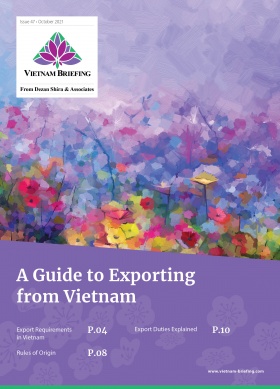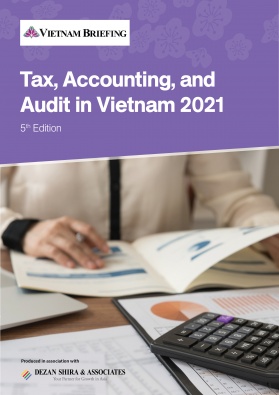Transfer Pricing in Vietnam – An Overview
Businesses in Vietnam need to ensure full compliance with transfer pricing regulations as tax authorities are likely to scrutinize businesses to ensure they meet their targets.The government issued Decree 132 on tax administration for transactions with related parties; the Decree replaces Decree 20 and Decree 68. Vietnam Briefing outlines the procedures and documentation necessary for foreign businesses to be compliant as per recent transfer pricing regulations.
Many foreign businesses delocalize their production facilities in Vietnam and charge their foreign outposts for administrative, technical, financial, and commercial services. However, financial administration teams need to be aware that their transactions must comply with the arm’s length and substance-over-form principles.
Before the government released Providing tax administration applicable to enterprises having controlled transactions (‘Decree 20’) in April 2017, followed by Decree 132/2020/ND-CP (Decree 132) in November 2020, which replaces Decree 20, transfer pricing rules in Vietnam were lax. Investors could enter the market without worrying too much about their transfer pricing policies.
Now, companies that are considering an investment into Vietnam, as well as those companies that are already operating in the country, need to comply with the stricter regulatory requirements in Decree 132, which are based on OECD guidelines and BEPS actions.
Read: What is a Transfer Pricing Review and Why Do Firms in Vietnam Need It?
Key compliance in Vietnam
Transfer pricing rules are almost the same everywhere as they are generally based on the same principles and share common approaches. Of course, there are small differences between Vietnam’s rules and other countries, but the core is the same.
Before Decree 20 and Decree 132 were issued, transfer pricing rules in Vietnam incorporated the arm’s length principle as their foundation. Accordingly, the biggest impact is the introduction of the substance-over-form principle: foreign investors should review this when structuring supply chains.
Substance-over-form is a principle by which tax authorities look past the legal forms of transactions and operating structures, and instead consider and analyze their economic substance.
What it means in practice
Foreign parent companies that delocalize their production facilities in Vietnam may seek to act solely as a subcontractor, operating through their Vietnamese subsidiary alone. The foreign parent company then seeks to charge its subsidiary on a monthly basis for commercial services performed in regard to developing sales in Vietnam.
According to the substance-over-form principle, those commercial services should contribute to the creation of operating sales revenue or income for the Vietnamese subsidiary. As a consequence, expenses related to commercial services are not deductible from the subsidiary’s taxable income.
Alternatively, if the same Vietnamese subsidiary were engaged in sales activities, then those same commercial service expenses would comply with the substance-over-form principle. Accordingly, the expenses could then be deducted if the prices charged were at arm’s length (or market rate).
Some companies, however, may seek to engage in more complicated relationships. A multinational enterprise may like to interpose a Vietnamese entity in transactions between two member companies that are residents of countries, which have not signed a double taxation agreement.
According to the substance-over-form principle, associated transactions should have a significant purpose (aside from reduction of tax liability) and an economic effect (aside from any tax effect) in order to be accepted by authorities. In this case, no related expenses would be deductible from the Vietnamese entity’s taxable income.
Finally, from a tax planning perspective, it is worth noting that the previous Decree 20 introduced limitations on the deductibility of loan interest costs, which now – after Decree 132 – should not exceed 20 percent of earnings before interest, taxes, depreciation, and amortization (EBITDA). This measure is aimed at addressing thin capitalization, as Vietnam lacks specific thin capitalization rules.
How to comply with transfer pricing regulations
Taxpayers in Vietnam that have entered into related-party transactions have a number of obligations under Decree 132. These have been summarized and set out below:
Forms
Companies in Vietnam that engage in related party transactions need to disclose their relationships and transactions in their annual tax returns.
Taxpayers subject to transfer pricing regulations need to file Form 01 – which is attached to Decree 132 – to disclose what transfer pricing transactions they have entered into, and the value of these contracts. Furthermore, taxpayers need to provide what the arm’s-length prices of the related-party transactions would be to enable a comparison.
The timeframe to do this is 90 days after the end of the financial year. This may prove very challenging given the short amount of time to collect and collate all necessary information and data – careful planning and observance are therefore prudent.
Contemporaneous documentation
Transfer pricing contemporaneous documentation is designed to document taxpayers’ relationships and transactions with related parties, as well as their global transfer pricing policies and the allocation of profits among all members/entities within a corporate group.
Taxpayers meeting specific thresholds must, in accordance with Decree 132, prepare, and then maintain transfer pricing contemporaneous documentation, which encompasses a Local File, and one or more of the Master File and Country-by-Country Report (CbCR).
It is likely that the Master File and CbCR will be prepared by headquarters, as they are likely to have direct access to all necessary information. All those documents must be declared by filing Form 02 and Form 03, attached to Decree 132 (for Local file and Master file respectively), and Form 04 (CbCR).
Safe harbors from contemporaneous documentation
According to Decree 132, enterprises are exempted from preparing the transfer pricing documentation if any of the following conditions are satisfied:
- Total revenue < VND 50 billion (US$2.5 million) and total revenue of related-party transactions < VND 30 billion (US$1.5 million);
- Entered into an Advanced Pricing Agreement (APA) and submitted annual APA report(s);
- Exercise only simple functions, sales < VND 200 billion (US$10 million) and EBIT, depending on business, of at least 5 percent (distribution), 10 percent (manufacturing), or 15 percent (toll manufacturing).
Audits
In the case of transfer pricing audits, taxpayers will have 10 working days to provide the transfer pricing documentation, while they will have 30 working days to provide it during the consultation procedures prior to the audit.
Risk/Penalties
If the tax authorities believe the transaction was not priced according to the arms’ length principle, they will adjust the value of the transaction and impose tax accordingly. Furthermore, according to the substance-over-form principle, costs arising from services rendered for the sole purpose of providing other affiliates with benefits or values will not qualify for a deduction from taxable income.
Companies can also be held criminally liable if found to be evading tax. The tax authorities also publish the details of companies that are non-compliant, or report irregularities, on their national and provincial websites – a critical reputational risk.
Managing risk
In light of the recent developments in local transfer pricing rules and the increasing interest on transfer pricing worldwide, it is important that companies take the necessary steps to ensure that they are compliant and effectively managing their risk. There are a variety of measures that companies can take. These include:
- Providing disclosures: All companies should disclose information about their related-party relationships and transactions in the prescribed forms and in accordance with the requisite timeframes.
- Risk assessments: Conducting risk assessments to monitor and revise intercompany transactions and planning ahead to create a robust transfer pricing strategy is also an important risk mitigation tool.
- Contemporaneous documentation preparation: Taxpayers meeting the abovementioned thresholds are required to prepare contemporaneous documentation. Companies not meeting the thresholds should however still accurately document their associated party transactions and be able to substantiate the rationale adopted in case they receive any queries or audit notices from the tax bureau.
- Advanced Pricing Arrangements: Taxpayers have the option to proactively manage their transfer pricing risk profiles by entering into an Advanced Pricing Agreement (APA) with the local tax authority. An APA is a binding agreement as to how taxpayers’ transfer pricing arrangement will be taxed.
Key takeaways
In light of the recent focus internationally on tax and transfer pricing through the Organization for Economic Cooperation and Development’s (OECDs) Base Erosion and Profit Shifting (BEPS) program, as well specifically in Vietnam through the laws such as Decree 132, companies engaging in related/associated party transactions are under increased scrutiny. It is important that these companies seek the appropriate advice to ensure that they are compliant and that effective risk mitigation measures are put in place.
Also read
About Us
Vietnam Briefing is produced by Dezan Shira & Associates. The firm assists foreign investors throughout Asia from offices across the world, including in Hanoi, Ho Chi Minh City, and Da Nang. Readers may write to vietnam@dezshira.com for more support on doing business in Vietnam.
We also maintain offices or have alliance partners assisting foreign investors in Indonesia, India, Singapore, The Philippines, Malaysia, Thailand, Italy, Germany, and the United States, in addition to practices in Bangladesh and Russia.
- Previous Article Foreign Employees Subject to Increased Social Insurance Rates from January 2022
- Next Article Tay Ninh Province: Promising for Investors in the Greater Mekong Subregion







